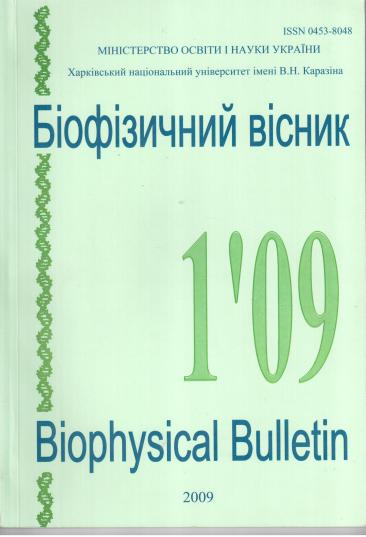Mechanism of thermal destruction on nucleic acids
Abstract
The thermal stability of polynucleotides (polyA, polyG, polyC, polyU and natural DNA), and their structural components (nucleotides, nucleosides, and deoxyribose) were studied by a method of differential scanning microcalorimetry. The dependences of heat flow on temperature for studied compounds with individual features in the temperature range from 20 up to 4000 С have been obtained. All samples give the exothermic peaks on the DSC curves at temperatures higher than 2000 С that correspond to processes of nonreversible thermal destructions of the structure. The temperatures and the effective heat of the thermal destruction for all samples were determined. The obtained data show that investigated polynucleotides have different thermal stability indicating a difference in binding energies among which the poly G is the most stable and DNA is less stable. The calorimetric analysis of polynucleotide structural components has shown that the exothermal character of nucleic acids destruction is determined by the process of D-ribose destruction. Based on our results and the literary source the mechanism of thermal destruction of the polynucleotide in solid-state was proposed. The initial reaction is glycosidic bond cleavage with hydrogen transfer from a sugar moiety to the nitrogen base. In consequence, the C-O bond between sugar and phosphate becomes unstable and breakdown.
Downloads
References
Marguet E., Forterre P. DNA stability at temperatures typical for hyperthermophiles. //
Nucl. Acid Res. 1994. V. 22. P. 1681-1686.
Lindhal T. Instability and decay of the primary structure of DNA. // Nature. 1993. V.
P. 709-715.
Sidney W. F., Doxe K. // Molecular Evolution and the Origin of Life, Revised ed. 1977.
Гасан А.И., Малеев В.Я., Филипский А.В. Исследование термической устойчивости
первичной структуры нуклеиновых кислот. // Вісник ХДУ, №568, Біофізичний
Вісник. 2002. вип. 2. Р. 20 – 24.
Kyoung J. P., Won J. Characterization of DNA/Poly (ethylene imine) Electrolyte
Membranes. // Macromolecular Research. 2007. V. 15. №. 6. P. 581-586.
Коршак В. В. // Термостойкие полимеры. 1969. М. Наука. 408 с.
Ohnishi A., Kato K., Takagi E. Curie-Point Pyrolysis of Cellulose. // Polymer Journal.
V. 4. P. 431-437.
Yaylayan V. A. Precursors, Formation and Determination of Furan in Food. // Journal OF
Consumer Protection and Food Safety. 2005. V. 1. P. 5-9.
Gross M. L., Lyon P. A., Dasgupta A., Gupta N. K. Mass spectral studies of probe
pyrolysis products of intact oligoribonucleotides. // Nucleic Acids Res. 1978. V. 5. № 8.
P. 2695-2704.
Yang J. Håkansson K. Fragmentation of Oligoribonucleotides from Gas-Phase IonElectron Reactions. // J Am Soc Mass Spectrom. 2006. V. 17. P. 1369–1375.
Puzo G., Wiebers J.L. Identification of modified nucleosides in intact transfer ribonucleic
acid by pyrolysis-electron impact-collisional activation mass spectrometry// Nucleic
Acids Research. 1981. V. 9. P. 4655–4667.
Wan K. X., Gross M. L. Fragmentation mechanisms of oligodeoxynucleotides: effects of
replacing phosphates with methylphosphonates and thymines with other bases in T-rich
sequences. // J Am Soc Mass Spectrom. 2001. V. 12. P. 580–589.
Strittmatter E. F., Schnier P. D., Klassen J. S., Williams E. R. Dissociation energies of
deoxyribose nucleotide dimer anions measured using blackbody infrared radiative
dissociation. // J Am Soc Mass Spectrom. 1999. V. 10. P. 1095–1104.
Klassen J. S., Schnier P. D., Williams E. R. Blackbody Infrared Radiative Dissociation of
Oligonucleotide Anions// J Am Soc Mass Spectrom. 1998. V. 9. P. 1117–1124.
Olafsson P. G., Bryan A. M., Lau K. A DSC-TLC analysis of thermolysis reactions
involving 2'-deoxynucleosides. // J. of Thermal Analysis. 1977. V. 11. P. 377—385.
Olafsson P. G., Bryan A. M. Thermal analysis of 5-halo-2'-deoxynucleosides. // Journal
of Thermal Analysis. 1977. V. 11. P. 359—376.
Authors who publish with this journal agree to the following terms:
- Authors retain copyright and grant the journal right of first publication with the work simultaneously licensed under a Creative Commons Attribution License that allows others to share the work with an acknowledgement of the work's authorship and initial publication in this journal.
- Authors are able to enter into separate, additional contractual arrangements for the non-exclusive distribution of the journal's published version of the work (e.g., post it to an institutional repository or publish it in a book), with an acknowledgement of its initial publication in this journal.
- Authors are permitted and encouraged to post their work online (e.g., in institutional repositories or on their website) prior to and during the submission process, as it can lead to productive exchanges, as well as earlier and greater citation of published work (See The Effect of Open Access).





